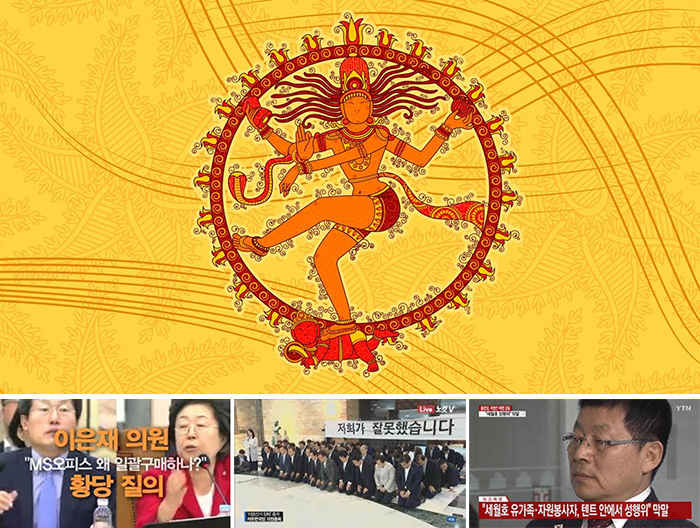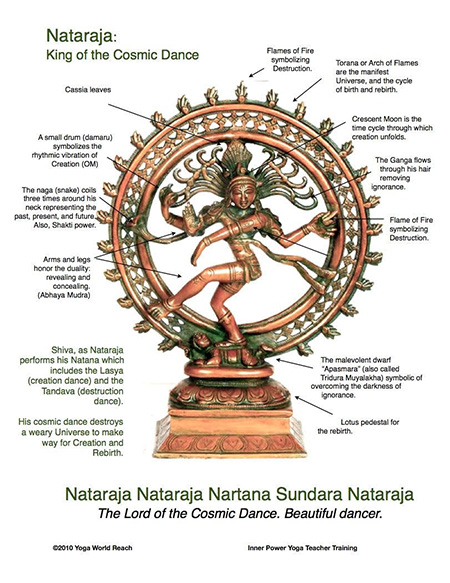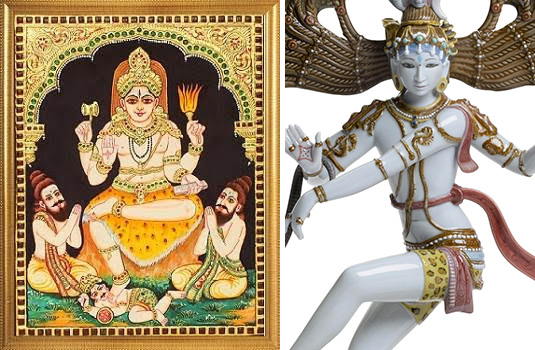 |
닐니리야~ 니나노~. 춤이 절로 나온다. 덩실덩실~. 앗싸 가오리~! 우리 다같이 으쓱으쓱~. 반주는 U2, 노래는 송가인~. 뭐라고요? 춤선생 한 분 소개해 달라고요? 그러쥬!
힌두의 신 가운데 나타라자라는 아주 훌륭한 춤선생이 계시다. 뭐 손동작, 발동작, 엉덩이 돌리기 등의 춤동작은 그림 참고하시고.....
이 춤선생이 훌륭한 춤꾼인 이유가 있다. 일단 춤을 가장 잘 추신다. 하지만 더 중요한 이유가 있으니 자신의 춤에 철학을 담았다는 것이다.
선생은 반드시 뭘 밟고 춤을 추신다. 그림 보시라, 발 밑에 웬 난쟁이를 밟고 리듬을 타신다. 밟힌 놈은 아파스마라라는 악귀다.
난쟁이는 무지, 막말, 망각, 부주의를 상징하는 악귀다. 선생은 춤을 추며 이런 악덕을 철학적으로, 지성적으로 즈려밟으신다.
근데, 우리의 춤선생은 관대하시다. 밟되 죽이지는 않는다. 왜냐, 사실 심오한 내용인데 단순하게 말하면 ‘지와 무지’의 균형을 이루기 위해서다.
 |
| ▶ 무지, 건망증, 막말(아래 왼쪽부터)을 밝고 춤을 추는 춤신(위) |
(부록)
춤선생
Nataraja. 우주의 신성한 춤꾼. 시바의 화신. The Lord of Dance. The divine dancer. His dance is called Tandavam or Nadanta. a depiction of the Hindu god Shiva.
난쟁이 악귀
Apasmāra is a dwarf who represents ignorance and nonsensical speech. To preserve knowledge in the world, Apasmāra must be subdued, not killed, as to do so would disturb the necessary balance between spiritual knowledge and ignorance. Killing Apasmāra would symbolise the attainment of knowledge without the (essential) effort, dedication and hard work involved, and this would lead to the devaluing of knowledge in all its forms. To subdue Apasmāra, Lord Śiva adopted the form of Śrī Naṭarāja - the Lord of Dance and performed the cosmic dance of Tāṇḍava. During this dance, Śrī Naṭarāja suppressed Apasmāra by crushing him with his right foot. As Apasmāra is one of the few demons destined to immortality, it is believed that Lord Śiva forever remains in his Śrī Naṭarāja form suppressing Apasmāra for all eternity.
 |
(춤 배우기)
기본 동작
- 부중가트라사(Bhujungatrasa, 뱀의 떨림) : 춤 추는 내내 뱀의 떨림을 잊으면 안된다.
- 아바야 무드라(Abhaya Mudra) : 손바닥을 앞으로 향하게 하고 앞쪽 오른손 손가락은 위로 향하게 한다. ‘무섭지 않아’를 표현하는 동작.
- 가자하스타(Gajahasta) : 앞쪽 왼손이 가슴을 가로질러 ‘코끼리 포즈’를 잡고, 손가락은 꺾어 들어올린 왼발을 향하게 한다.
소품
- 다마루(Damaru) : 모래시계처럼 생긴 북. 등 뒤 오른손으로 잡는다.
- 아그니(Agni)와 용기 : 불을 용기에 담아 등 뒤의 왼손 손바닥 위에 둔다.
- 화염의 고리 : 춤선생을 둘러싸고 있는 불의 고리. (화염의 고리는 세계의 파괴와 해체를 의미하는데, 파괴와 해체는 창조의 근원이다. 미통당은 참고하시라.)
각 동작과 소품의 의미
- 오른발 동작 : 화신(땅을 딛고 서 있다)
- 왼발 동작 : 해방(들어올리고 있다)
- 손 동작 : 보호
- 북 : 창조
- 화염의 고리 : 파괴와 해체
It typically shows Shiva dancing in one of the Natya Shastra poses, holding Agni (fire) in his left back hand, the front hand in gajahasta (elephant hand) or dandahasta (stick hand) mudra, the front right hand with a wrapped snake that is in abhaya (fear not) mudra while pointing to a Sutra text, and the back hand holding a musical instrument, usually a damaru. His body, fingers, ankles, neck, face, head, ear lobes and dress are shown decorated with symbolic items, which vary with historic period and region. He is surrounded by a ring of flames, standing on a lotus pedestal, lifting his left leg (or in rare cases, the right leg) and balancing / trampling upon a demon shown as a dwarf (Apasmara or Muyalaka) who symbolizes ignorance.
 |
(심화학습)
Who is the Dwarf in the Cosmic Dance of Shiva?
In the images of Nataraja, you might have seen a little dwarf, called apasmara, being crushed under his dancing feet. That little dwarf represents the ignorant, deluded being, Jiva, who is subject to the triple impurities of littleness (anava), desires and attachments (pasa), and delusion (moha) caused by ignorance. The purpose of Shiva’s dance is to facilitate the order and regularity of the world, and the liberation of souls through an intense transformative process under his twin feet of births and deaths, and duality.
For the mortal beings, anava is a problem. Anava means egoism, smallness, or atomicity. Anu means atom, Anava means choosing to be like an atom, when in reality you are the supreme Self. It is the natural state of all living beings, but not the ideal one, since it is not conducive to liberation. In reality you are limitless, eternal, indestructible, and indivisible. Your ego makes you feel that you are a limited being, distinct and separate from the rest of creation. It is also responsible for your pride, ownership, desire-ridden actions, attachments, possessiveness, modifications of your mind, birth and death.
 |
| ▶ ‘맞절’ 혹은 ‘춤선생에게 밟힐 준비를 하는 황교안과 김진태’ |
By a casual observation you can easily see that you are a fragmented person, with numerous parts. Both your mind and body have several parts, and each of them is further divided into numerous other parts. Together they create you, a complex being with fragmented awareness, and a distinct individuality that separates you from the rest.
In the fragmented mind you experience duality and division and find it difficult to accept any notion of being limitless, or eternal. You see your body and know that it is impermanent and subject to death and decay. You see others, and you know that they are different from you and cannot be you. You see suffering everywhere, little children dying, animals getting shot, people behaving cruelly, and numerous other disturbing images, which make you feel that the world is a wretched place for good people. All that is true, at least from your perspective. Every day many things happen in this world, which hurt your sensibility and sense of justice. They keep you bound to your judgment, worldview and your sense of righteousness.
When you see things from a limited perspective as an individual, and accept them as true, you should know that it is your ego which is at work and which is responsible for the duality and separation that you experience. Your ego may feel righteous, but righteousness coming from your ego is still a problem because it strengthens your ego rather than facilitating liberation. In Hinduism, this state is described as smallness or atomicity (anava). In this state you identify yourself with your mind and body and accept your physical identity as true, and you use it to define yourself and relate to others. It is also the state of delusion, where cannot properly discriminate between truth and falsehood.
Your ego practically stays in control of your life and asserts itself in numerous aspects of your thinking, behavior, and actions. Your beliefs, faith, knowledge, wisdom, attitude, relationships, judgment, feelings, opinions, are colored by it. You do not know your ego as a separate entity because in wakeful state it envelops your consciousness and represents your identity. You will become aware of it only in deep, meditative states as you become the observer or a passive witness. Your ego is the sum of your mind and body complex, and your conscious experience. It is the totality of who you are, and how you perceive yourself. If you feel unhappy, happy, angry, sad, worried, anxious, envious, ambitious, or fearful, know that it is the reaction of your ego.
Aanava, your smallness, pits you against the gigantic forces of the universe and creates in you fear, anxiety, insecurity and numerous other emotional responses, whereby you develop attachments and indulge in desire-ridden actions to fortify yourself against possible threats. Since you are limited by its influence and modes, you do not experience life in its totality, or the transcendental state of limitless and choiceless awareness.
How can you deal with the problem of ego and the limitedness it creates so that you can permanently escape into an eternal world? How can you find an eternal relief from the twin problems of births and deaths as represented by the dancing feet of Shiva, the lord of Death? The scriptures offer numerous suggestions. You may also find solutions from several sources and in different traditions. Here are a few important ones mentioned by the enlightened ones.
 |
| ▶ 세상의 균형을 잡느라 완전 밟아죽이지는 않는다. |
First, know how to identify your ego and understand its working and behavior. Next, stop identifying yourself with your mind and body and cultivate detachment. Third, withdraw your mind and senses and turn inward to practice meditation and mindful observation to become your own witness. Fourthly, stop acting according to the prompting of your ego with the following. Silence your desires, expectations, opinions, reactions and emotional responses. Reduce your dependence upon things and people to whom you are attached. Control your compulsion to control the world, or to claim things that do not belong to you. Do not indulge in actions to profit yourself. Finally, overcome selfishness, greed, envy, pride, malice, and delusion through spiritual practice and self-purification.
Practices such as the ones mentioned above would greatly weaken your ego and its hold upon your consciousness. As long as you have mind and body, your ego will not die. It will become weak, but still it will keep surfacing in your thoughts and actions. Therefore, you should remain on guard, without being complacent, until you enter the state of choiceless, transcendental awareness, in which you will view the dualities of life with sameness and equanimity and without judgment, and in which you cease to objectify your experience or act according to your modes.
In worldly life, your ego is your support and an ally, but in spiritual life it becomes your antagonist. If you are in search of peace and mental stability, you should pay attention to how your ego creates suffering through desire-ridden actions, duality, attachments, and attraction and aversion. When your ego is silent and subdued, you enter the state of Shiva and cease being a little dwarf. With the vision and wisdom of an awakened seer (siddha), you let life happen, without the desire or the compulsion to control it, manage it or manipulate it. You embrace all your perceptions and experiences without choice, preference, or prejudice. Just as God embraces everything that he projects outwardly with sameness and pervades it as its very essence, you pervade your whole awareness and become the totality of your experience.
Thoughts for contemplation: Your ego attaches itself to numerous things and extends your identity far beyond your physical and mental appearance. For example, nationality, religious and cultural identities are but extensions of the ego only. Religious temperament, fanaticism, intolerance also arise from the sacred ego, rather than the sacred Self. The ego is good at using all the good and bad things in life according to its moral percepts, including knowledge, religion, wealth, power, position, and morality to its best advantage either to establish its superiority, status, or distinction or to manipulate others. (너무 길어서 이하생략!)
관리자 freemediaf@gmail.com
<저작권자 © 자유언론실천재단, 무단 전재 및 재배포 금지>

